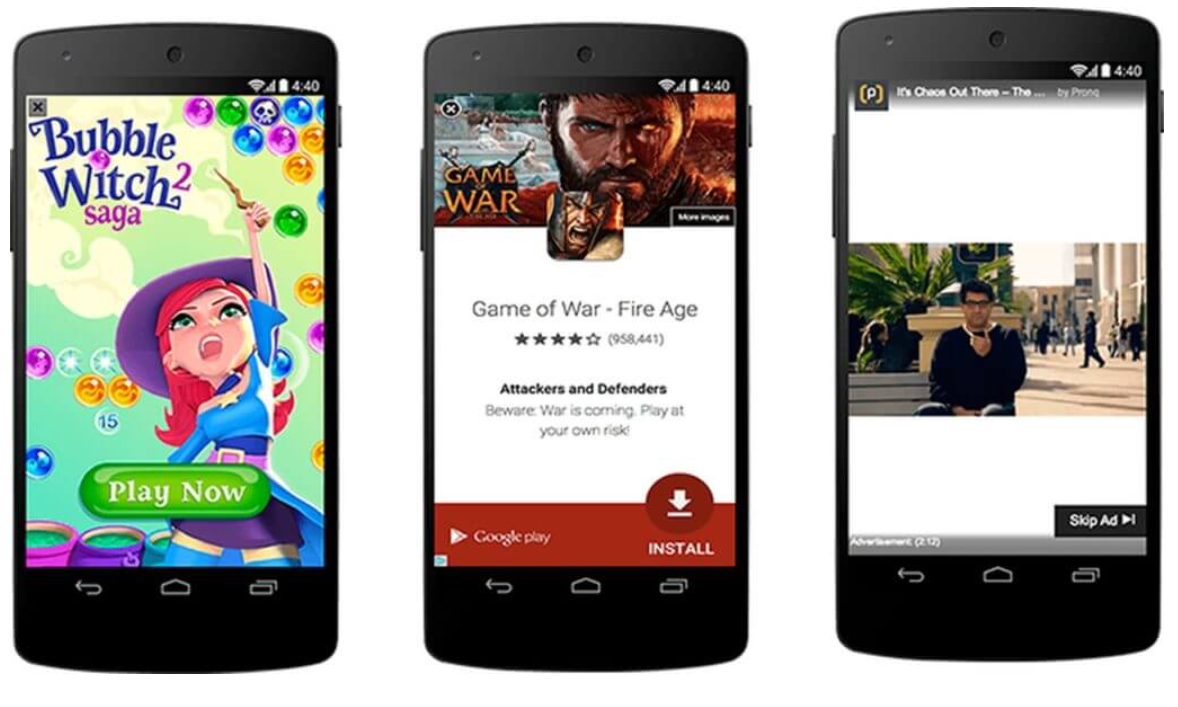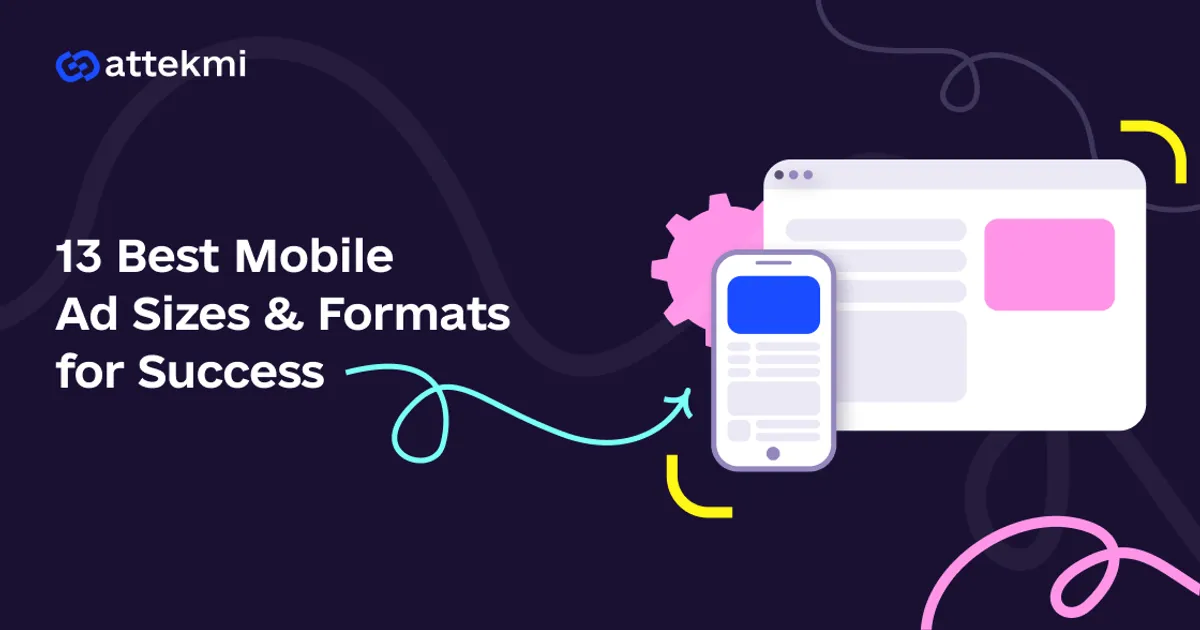The modern mobile-driven world implies loads of opportunities for all the parties involved in digital advertising. While marketers can target their potential customers on the go, publishers monetize their ad inventory. In turn, owners of ad exchanges increase their media trading income by offering mobile advertising to their partners.
However, there are multiple options to choose from, and making this choice can be challenging. In this guide, we will explore the best-performing ad sizes and formats to help you.
Understanding Mobile Ad Formats
Banners
Banner ads are rectangular display ads that occupy a prominent position at the top, bottom, or sides of a mobile app or website. They serve as an unobtrusive yet effective way to attract users' attention.
Mobile banner ads sizes vary, from the traditional 320*50 pixels to larger formats like 300*250 pixels. Those are versatile and can be static or animated, providing ample room for creativity.
Interstitials
Interstitial ads, often referred to as splash pages, are full-screen advertisements popping up during breaks in a user’s interaction with an app or website. They offer a visually immersive experience, making them ideal for capturing undivided attention.
These ads are commonly used in gaming apps, news apps, and content-rich websites. The key is to achieve harmony between user experience and ad frequency to guarantee maximum impact.

Videos
Videos aren’t new mobile advertising formats, but they are vibrant and engaging forms of advertising that deliver content in a visual and auditory format. They can be further categorized into in-stream and out-stream videos.
In-stream videos play before, during, or after the content a user is viewing. Out-stream videos, on the other hand, are standalone ads that appear within the content flow, providing a seamless viewing experience. Video ads should be concise, typically ranging from 15 to 30 seconds, to maintain viewer engagement.
CTV (Connected TV)
CTV ads are tailored for smart TVs and other Internet-connected devices, tapping into the expanding realm of streaming services. With the rise of platforms like Netflix, Hulu, and Amazon Prime Video, CTV ads offer a powerful way to reach a diverse audience.
CTV ads can be displayed on different gadgets, including mobile, in formats that enlist pre-roll, mid-roll, and post-roll, providing ample opportunities to engage viewers.
In-app (Banner In-app & In-app Video)
This category includes both banner in-app ads and in-app video ads, which, by the way, appear to be the greatest profit drivers on Attekmi solutions for most clients.
In the US, around 88% of mobile time is spent in-app. Thus, it helps publishers maximize their gains and help advertisers reach more customers.
Banner in-app ads maintain a non-intrusive presence, appearing at strategic points within the app. In-app video ads, on the other hand, offer a captivating and dynamic way to convey your message. They can be skippable or non-skippable, allowing for flexibility in content delivery.
Additional effective in-app advertising formats include rewarded video ads, rich-media ads, playable ads, offerwall ads, splash ads, etc.
Native
Native vs display ads? It’s a popular question. Let’s explore it further.
Native ads ensure a non-disruptive advertising experience since they mimic the surroundings of the app or the social feel where they are typically set.
Native mobile ads consist of tailored elements that are presented to users through user interface components inherent to the platform. Native mobile advertising is customized to mobile applications or mobile games to perfectly harmonize with the apps’ visual aesthetics so they are often perceived more positively by the apps’ users.
In essence, effectively implementing native ads involves two key components: loading an ad via the SDK and then integrating the ad content seamlessly within an app for a highly effective ad interaction with app users, aligning more closely to the consumer’s mindset.
Native ads are particularly effective in social media feeds, news articles, and content discovery platforms. They resonate with users by providing relevant, contextually-driven messaging.
Mobile native ad formats support huge variations of advertising units.
For example, mobile native advertising formats can come in the form of push notifications (immediate system notifications) or recommendation widgets on the website (normally mobile web ads).
Push
Push notifications are short, impactful messages delivered directly to a user’s device. They demand immediate attention and can be highly effective for promotional ads like hot offers with limited-time announcements. Pushes normally work just well when personalized for every user while taking into account their location, interests, and behavioral data (if applicable).
Pop
Pop-up ads are attention-grabbing visuals that appear abruptly on top of a mobile screen. While they can be invasive, when used judiciously, pop ads work effectively in seizing user attention in a landslide.
Pop ads are commonly used for special promotions, limited-time offers, or calls to action that require immediate action.
Audio
Audio ads leverage sound to convey marketing messages. They provide an auditory experience to users, making them an effective choice for media like music streaming services and podcast applications.
Audio ads should be carefully crafted to deliver a compelling message within the short duration of the ad slot.
Understanding Mobile Ad Sizes
Now that the most effective formats have been explored let’s find out which mobile ad sizes are best for website monetization and driving customers’ attention.
Rectangle Ads
Rectangle-shaped ads can often be seen between paragraphs of text, at the end of the article, or as interstitials. Their sizes vary, but here are the most effective ones:
300×250. Most marketers prefer this size for their best mobile banner ads, meaning that publishers offering such inventory gain access to a large pool of advertisers.
336×280. Even though this option is larger than the previous one, it is still popular among advertisers and publishers.
360×300. This mobile banner size is popular due to its universality. It performs well on smartphones, tablets, and desktops.
300×600. Ads of this size cover most of the screen, so they are effective in terms of attracting attention and driving impressions.
Square Ads
Square ads obviously refer to mobile ad units where height and width are equal. However, 336×336 is among the most popular mobile ad sizes as it offers more space for the creative and is more noticeable.
Leaderboard Ads
Basically, leaderboard ads also have a rectangular shape, but they are less obtrusive since their height is not that significant. Usually, they are placed at the top or bottom of the screen, and the following sizes are the most effective:
320×50. It is the most standard leaderboard size designed to fit the phone’s screen and optimized for portrait mode.
320×100. Being slightly higher, ads of this size are often used in the same context as large banners.
360×120. This option is also among standard mobile banner ad sizes.
728×90. This size performs well on smartphones, tablets, and desktops, but advertisers need to apply responsive design techniques when preparing their creatives.
Video Ads
Video ads are highly effective in terms of drawing attention and increasing engagement, and their most popular sizes are as follows:
320×180. That is the standard size for mobile video ads.
320×480. This size is typical for video interstitial ads delivered in portrait mode.
480×320. This option is basically the same as the previous one but for the landscape mode.
Choosing the Right Format for the Ad Campaign
Your demand partners may run different types of ad campaigns and different mobile ad types. They normally take into account the following factors when determining which kind of traffic to choose.
Target Audience
Understanding the audience’s preferences, behaviors, and demographics is paramount in choosing a format that resonates with them.
Campaign Objectives
Different ad formats serve different purposes. Demand partners usually choose ads that raise brand awareness, drive conversions, or encourage user engagement.
Industry
Each industry has unique dynamics and consumer behaviors. Demand partners usually identify the most effective approach for their particular sector. For instance, e-commerce campaigns may benefit from dynamic product-focused ads, while content-driven platforms may find success with native advertising.
For you as an ad exchange owner
For you as an ad exchange owner, the main goal is to determine what kinds of ad formats are the most popular among your demand partners. This way, you will be able to take necessary actions (for instance, connect more supply partners with such kinds of traffic).
How to Implement Mobile Ad Formats Effectively?
Implementing mobile ad formats requires a strategic approach to ensure maximum impact. Here are some actionable tips that your demand partners can implement to achieve greater campaign success on their part.
A/B Testing and Optimization
Regularly test different ad variations to identify what resonates best with your audience. Analyze metrics such as click-through rates, conversion rates, and engagement levels. Optimize based on these insights to continually improve performance.
Align Ad Formats with Campaign Objectives
Ensure that the chosen format directly supports the goals of your campaign. For example, if your objective is to drive app installs, consider utilizing in-app ads with clear call-to-action buttons.
Optimize for Mobile User Experience
With the majority of Internet traffic coming from mobile devices, it’s crucial to prioritize mobile-friendly designs and content. Ensure that landing pages are responsive, load quickly, and offer a seamless experience. This not only improves user satisfaction but also positively impacts ad performance.
Leverage Advanced Targeting Options
Many ad solutions feature sophisticated targeting capabilities, letting media buyers reach specific demographics, behaviors, and interests while applying different types of mobile ads. Utilize these features to refine your audience and increase the relevance of your ad content.
Monitor and Adjust in Real Time
Keep a close eye on the performance of your ad campaigns in real time. Identify any trends or anomalies and be prepared to make adjustments as needed. This agility is essential in maximizing the impact of your advertising efforts.
As you know for sure which formats are the most popular in your ad exchange, you have an amazing chance to seamlessly enable them for your demand partners.
For this, while configuring endpoints, tick the formats that you want to enable for these partners and choose the needed traffic type.
Consider Attekmi Your Trusted Partner
Attekmi solutions allow companies of different sizes and budgets to launch and efficiently run their own ad exchange. Thanks to a quick, professional launch, companies have a big perspective on achieving payback and revenue growth much faster than they usually go with platforms built from scratch.
Attekmi’s exclusive approach includes all-encompassing customer support from expert guidance and cost-cutting innovative technology. This powerful combination propels our clients’ businesses towards awesome results, often much better than was expected.
Take a look at the case studies of Attekmi and explore the detailed description of our partners’ programmatic business journey and their impressive results.
Wrapping it Up
In the modern world, where the number of smartphone users is growing continuously, incorporating mobile advertising has become a must. There are multiple formats and sizes to choose from, and in this guide, we have covered the most effective of them. However, for both advertisers and publishers, it is still crucial to analyze the performance to identify formats and sizes that work best specifically for them.
As for the owners of ad exchange solutions, they have to meet the needs of their demand and supply partners by offering them mobile advertising. With Attekmi solutions, this task is easy since all the essential features have already been implemented. The list of ad formats includes banner, video, audio, native, pop, and CTV ads, while the available traffic types are in-app, mobile web, desktop, and CTV.
Does Attekmi seem to be the right solution for you? Then let’s get in touch!
FAQ
How can I determine the mobile ad format for my goals?
To choose the optimal ad format, consider your target audience, campaign objectives, and industry trends. Conducting thorough market research and A/B testing can provide valuable insights. Use standard mobile ad sizes for the environment in which you will be placing ads.
How long should mobile video advertising formats be?
Mobile video ads should be concise, ideally between 15 to 30 seconds, to maintain viewer engagement. Shorter mobile advertising formats tend to perform better on mobile platforms.
Can I use a combination of different mobile ad formats within the same campaign for better results?
Yes, leveraging a mix of formats can provide a more comprehensive flow and improved results. However, ensure that the formats complement each other and contribute to a cohesive campaign message.
Which ad formats are not available on mobile devices?
While the list of supported mobile ad units is rather extensive, the following formats are not available: overlay ads, bumper ads, and skippable and non-skippable video ads.
 By Iryna Kozirevych
By Iryna Kozirevych